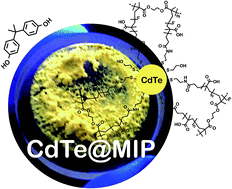Supercritical CO2-assisted synthesis of an ultrasensitive amphibious quantum dot-molecularly imprinted sensor†
Abstract
Molecularly imprinted polymers are simple and robust materials for the selective binding of analytes with affinities and selectivities similar to biological probes. A green supercritical CO2-assisted molecular imprinting protocol enabled the production of smart sensory particles, incorporating quantum dots, with molecular recognition to bisphenol A at very low concentrations (4 nM). The protocol uses amphibious vinyl-coated quantum dots and enables the design of sensors for a wide range of molecules through a simple, low cost and clean technology.


 Please wait while we load your content...
Please wait while we load your content...